

You can also download the files from a nearby mirror. The releases listed here are part of the Alternative Architecture Special Interest Group (AltArch SIG). You should always verify your downloads before using.īittorrent links are also available from the above links. You can also use the file located in any CentOS directory with ISO or Cloud images. Sha256sum information via an https source is provided in the Release Email or Release Notes link above. Verifying : epel-release- 7- 14.DVD and NetInstall images (including checksums) are available on mirrorsĭVD and NetInstall x86_64 images are available on mirrors ( checksums).ĭVD, Minimal, Everything, LiveGNOME, LiveKDE and NetInstall x86_64 images are available on mirrors ( checksums). Installing : epel-release- 7- 14.noarch 1/ 1 > Package epel-release.noarch 0: 7- 14 will be installedĮpel-release noarch 7- 14 /epel-release-latest- 7.noarch 25 k Marking epel-release-latest- 7.noarch.rpm to be installed

Just type the following yum command on a CentOS 7 or RHEL 7:Įxamining epel-release-latest- 7.noarch.rpm: epel-release- 7- 14.noarch Method #1: Install Extra Packages for Enterprise Linux repository configuration (recommended) The following instructions assumes that you are running command as root user on a CentOS/RHEL 7.x system and want to use use Fedora Epel repository. How to install EPEL repo on a CentOS and RHEL 7.x

The EPEL repository was created by the EPEL group working at the Fedora Project.


 0 kommentar(er)
0 kommentar(er)
